Bathrooms
The Destroilet Automatic Combustion Toilet
The Destroilet was the first commercially successful incinerating toilet. They were sold in the 1960s and 70s, but after that the company seems to have gone out of business. Incinerating toilets, however, can still be bought.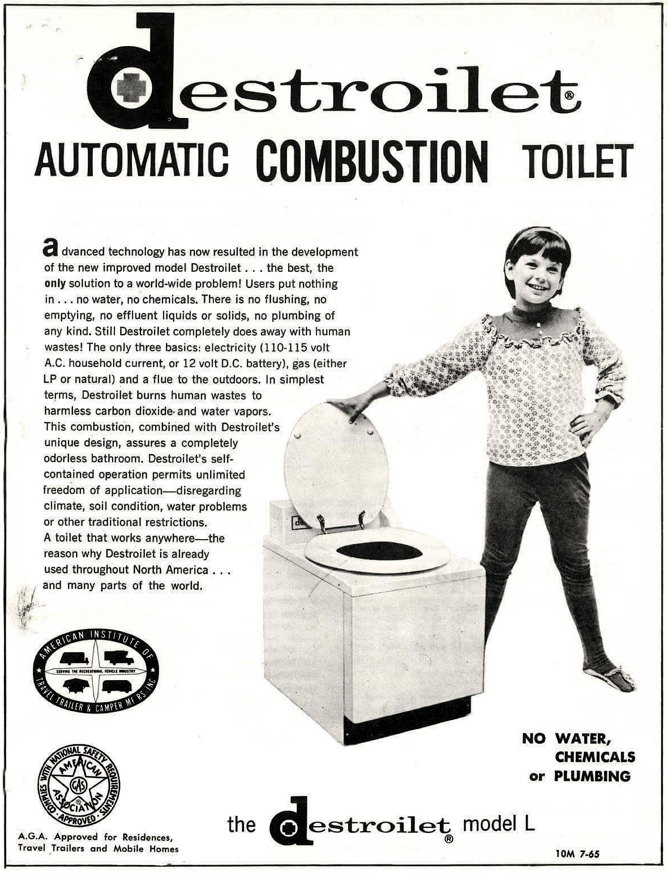
image source: kohoso.us
More info from Lifting the Lid: An ecological approach to toilet systems (1999), by Peter Harper and Louise Halestrap:
Disadvantages:
- an electricity connection is needed
- electricity consumption potentially significant – often the toilet will become the largest-consuming appliance in the house
- they are vulnerable to SHOCK LOADS – there is an upper limit to the rate at which it can accept inputs over a short period
- problems often arise if the unit is not in continual use
- the product may be hygienic when removed, but may not be actually composted and requires further treatment to become stable
- there is a risk of total failure in the event of an extended power-cut
Sometimes such compact electrical toilets are the best and only solution, but in practice users are often dissatisfied. The units are very sensitive to misuse – readily overwhelmed by a serious party, for example. Re-commissioning after a breakdown is not a job for the faint-hearted. A common problem arises when the units are installed in holiday-homes and are left for long periods without use. The de-watering process can sometimes transform a mixture of toilet paper, urine and faeces into a kind of paper mâché that coats the innards of the toilet so tenaciously that it is almost impossible to remove. Its strength is so impressive one imagines there could be industrial applications for it.
Posted By: Alex - Sat Oct 21, 2023 -
Comments (1)
Category: Bathrooms, Body Fluids, Excrement
Automatic Washing Machine for Dogs
Mario Altissimo was granted Patent No. 4,505,229 in 1985 for his "Automatic Washing Machine for Dogs and Like Animals".I wonder if anyone has ever created an equivalent type of automatic washing machine for humans.
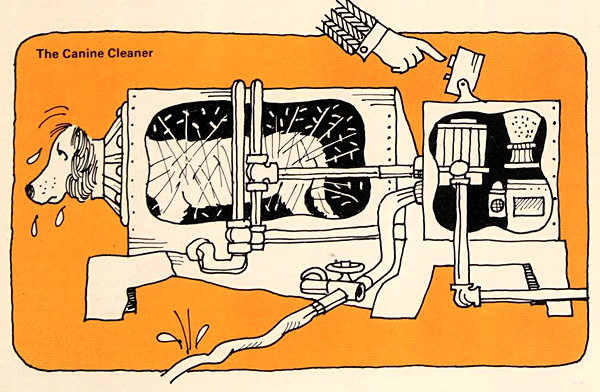
Science Year 1983
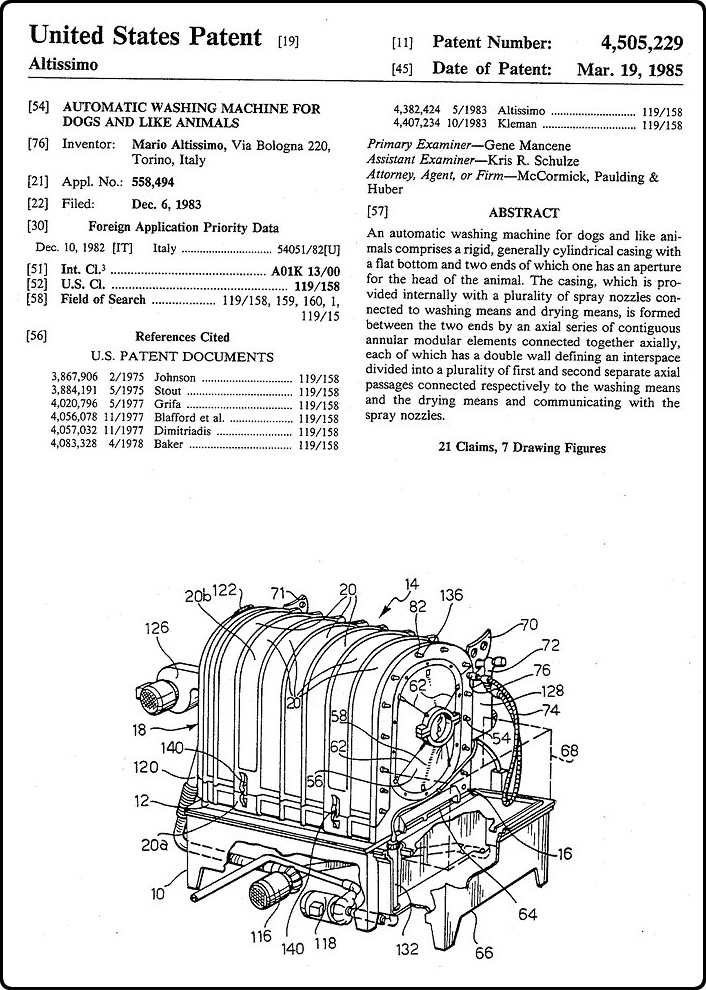
Update: Paul gave me a heads up about this Three Stooges take on a washing machine for dogs. A clear example of prior art!
Posted By: Alex - Mon Jun 13, 2022 -
Comments (5)
Category: Bathrooms, Patents, Dogs, 1980s
Zero Gravity Toilet Instructions
This has been circulating around for a while, but it was new to me so perhaps it'll be new to others as well.In one scene during 2001: A Space Odyssey, the character of Dr. Heywood Floyd uses a "zero gravity toilet" while he's on the space station. He's shown briefly examining the lengthy list of instructions on the wall next to the toilet.

Stanley Kubrick was so obsessive over details that, instead of using gobbledygook, placeholder text for the sign, he actually had someone create a list of toilet instructions. Film buffs have extracted this text, and it's available for purchase as a poster (perhaps to hang in your bathroom) or printed on a t-shirt. (I won't link to any specific retailers, but they're easy enough to find using Google).
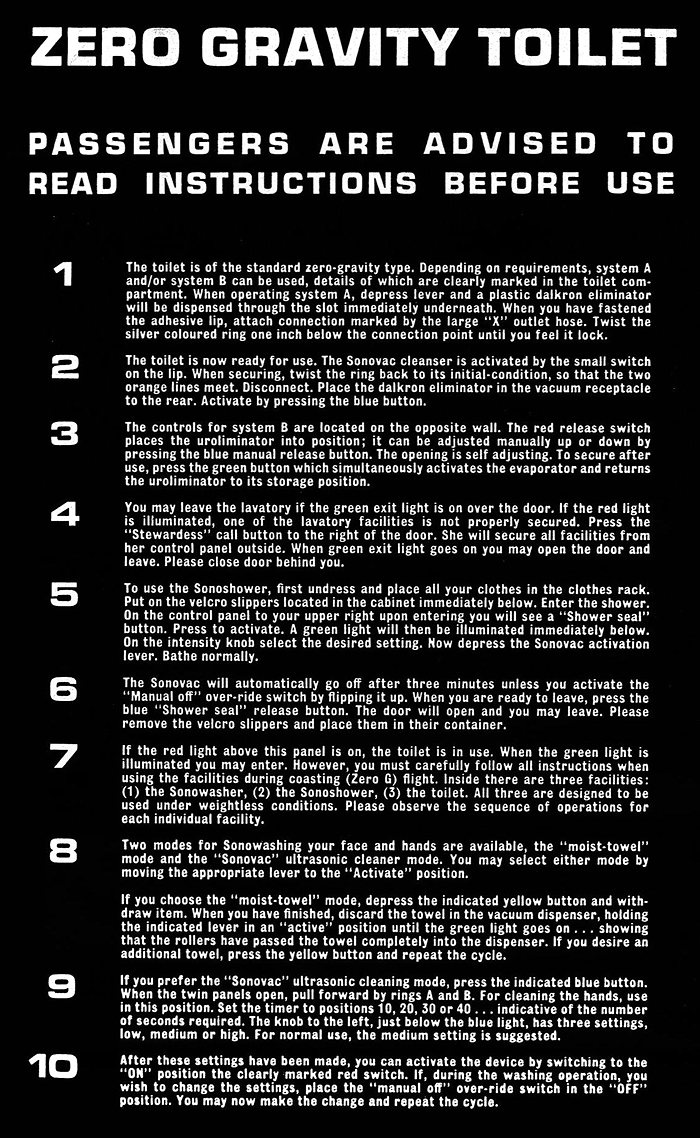
Far Out magazine suggests the zero-gravity toilet instructions may have deeper meaning within the broader context of the film:
Posted By: Alex - Fri Aug 13, 2021 -
Comments (3)
Category: Bathrooms, Movies, Space Travel
Octopus found in Restroom
The Equinox Bar, on the 22nd floor of the Hyatt-Regency, was the only revolving restaurant/bar in San Francisco, until it closed in 2007.In April 1978, a large octopus was found in the women's restroom of the bar. I haven't found any follow-ups to this story explaining why someone left an octopus there.
So the incident remains a mystery, just like the porpoise found in the men's restroom of Glasgow Central Station in 1965.
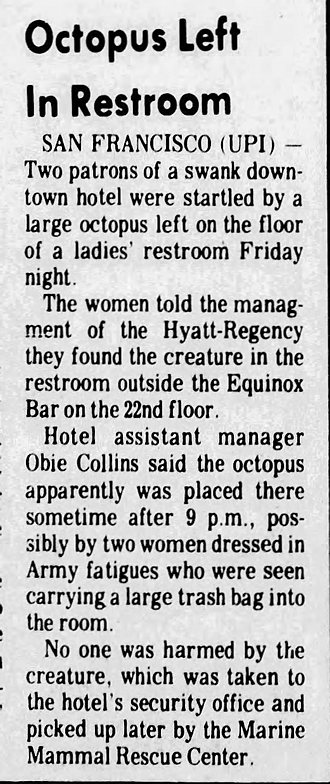
Napa Valley Register - Apr 22, 1978
Posted By: Alex - Wed May 12, 2021 -
Comments (4)
Category: Bathrooms, Fish, 1970s
Stockpiling toilet paper - 1993
July 1993: A pro-timber group urged consumers to stockpile toilet paper in order to deplete store supplies and thereby raise awareness of the importance of wood and paper products. "You can help by buying one or two (or twenty!) cases of toilet paper," its newsletter declared.Little did they know that, 27 years later, a pandemic would transform America into a nation of toilet paper stockpilers!

Longview Daily News - July 15, 1993
Posted By: Alex - Mon Jan 11, 2021 -
Comments (3)
Category: Bathrooms, 1990s
Flush Ratings
In 1974, the Lafayette waterworks in Louisiana revealed an apparent correlation between drops in water pressure and television viewing habits. In particular, the water pressure would drop immediately after popular shows and movies had aired... presumably from viewers waiting until the end of the shows to relieve themselves:So, the idea was floated that flush ratings might serve as a surrogate for the Nielsen ratings.
I had always thought that the idea of popular TV shows having an impact on sewage systems was an urban legend. However, while Snopes dismisses the idea that any shows such as the Superbowl have ever broken a city's sewage system, they allow the lesser claim that massive simultaneous flushing can put an observable strain on a city's waterworks, noting: "toilet use during breaks in large-audience programs can certainly be much higher than average."
Related post: Flush Polling
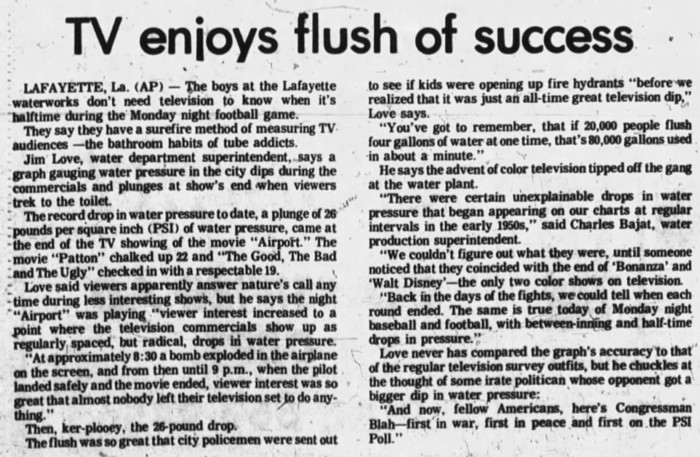
North Adams Transcript - July 5, 1974
Posted By: Alex - Fri Oct 09, 2020 -
Comments (2)
Category: Bathrooms, Television, 1970s
Disease detection toilet using dog
Patent #10,455,817 was granted in Oct 2019 for "animal olfactory detection of disease as control for health metrics collected by medical toilet."In plainer language, it's a toilet that has a small door built into the side of it (the "scent dispenser"), allowing a dog to smell your poop (or other bodily fluids) in order to detect the presence of disease. From the patent:
An animal may be trained to sniff the scent dispenser in response to a command or signal. The user may give the animal the command or signal when the user desires the animal to assess the presence of disease in the user.
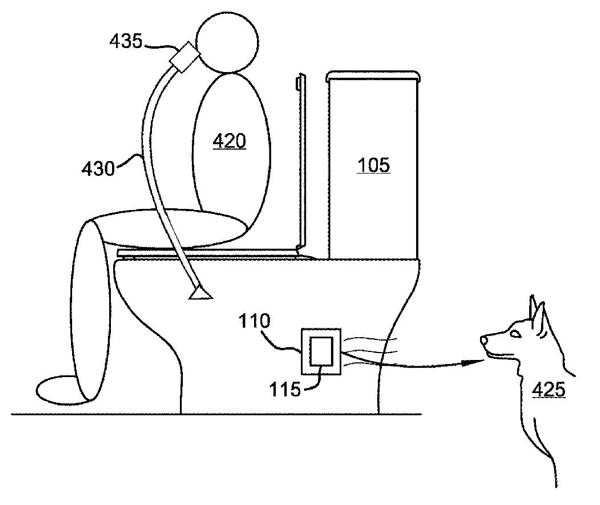
Posted By: Alex - Sun Oct 04, 2020 -
Comments (2)
Category: Bathrooms, Inventions, Patents, Dogs
Hitler’s Toilet Seat
December 1969: ex-RAF pilot Guy Harris put a toilet seat up for auction that he claimed to have removed from Hitler's bunker in Berlin. He said he had found it in the private apartment used by Hitler and Eva Braun.According to Harris, he and other British soldiers had been allowed in the bunker by the Russians, who had already removed everything they believed to be of value. But they evidently hadn't thought Hitler's toilet seat was of any value. So Harris took it.
When he got back to England, he first installed it in his 90-foot yacht on the Thames. Later he moved it to his home in Twickenham, before finally deciding to sell it.
There's no record, however, of whether he did manage sell it. At least, none that I can find.
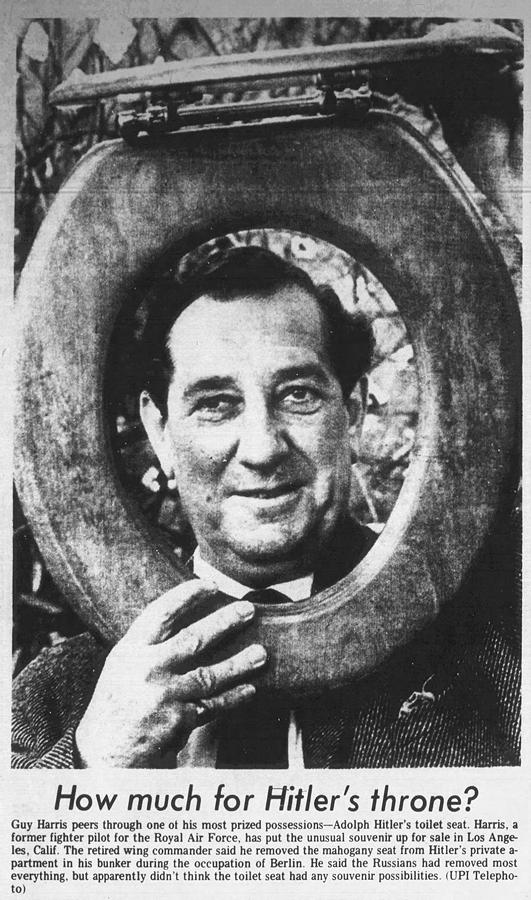
Albany Democrat Herald - Dec 18, 1969
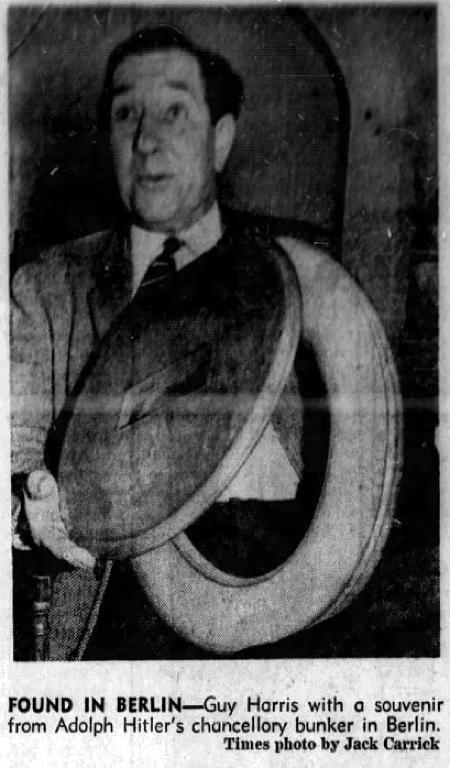
Los Angeles Times - Dec 17, 1969
As it turns out, Harris wasn't the only soldier to have nabbed a Hitler toilet seat. There are two more floating around out there. One was taken from Hitler's mountain retreat, the Berghof. The other from Hitler's private yacht, the Aviso Grille. This latter one is currently located in an auto repair shop in New Jeresy. More info: Anchorage News
Posted By: Alex - Sun Aug 16, 2020 -
Comments (1)
Category: Bathrooms, Dictators, Tyrants and Other Harsh Rulers, 1960s
Porpoise in toilet
I've heard of alligators in the sewer, but not porpoises in toilets.I haven't been able to find out if there was ever a solution to the mystery of how a porpoise came to be in the toilet of the Glasgow train station. I'm assuming student pranksters were probably involved.
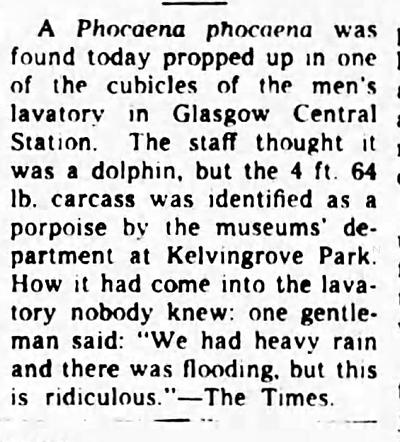
Ottawa Journal - Dec 7, 1965
Posted By: Alex - Mon Jul 27, 2020 -
Comments (3)
Category: Animals, Fish, Bathrooms, 1960s
Clean Hands Assured
Claude Davis of Melbourne, Florida obtained a patent for this curious device in 2000. It seems newly relevant in the era of coronavirus.The gadget attached to bathroom doors. Whenever someone turned the handle to open the door, the gadget would spray their hand with dye. This, reasoned Davis, would encourage people to wash their hands, to remove the dye. He imagined his invention might be useful in restaurants and hospitals that have "statutory type hygiene requirements to have their staff and employees clean their hands after using restroom facilities."
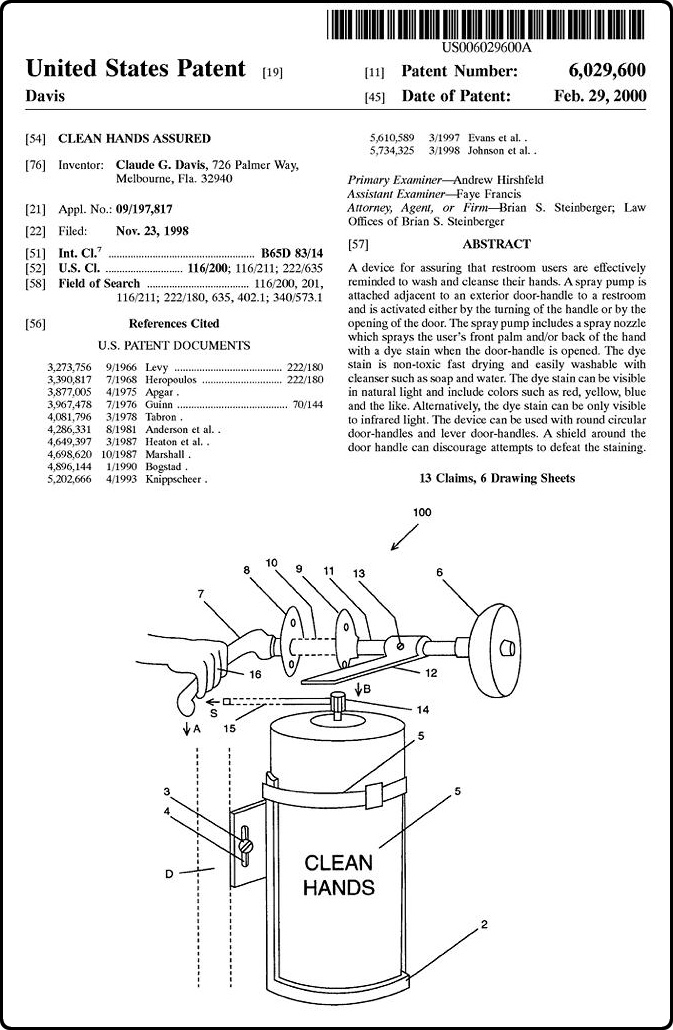
Although the invention had good intentions, I can think of several problems with it.
First, I'm sure that most employees would find it incredibly obnoxious to have their hand sprayed with dye every time they went to the bathroom.
Second, wouldn't the gadget also spray dye whenever someone exited the door... spraying into empty air? In which case, half the dye would be wasted. I can imagine employees standing on the inside of the door, pumping away at the door handle until all the dye was used up.
Posted By: Alex - Sun Apr 19, 2020 -
Comments (2)
Category: Bathrooms, Hygiene, Inventions, Patents

| Who We Are |
|---|
| Alex Boese Alex is the creator and curator of the Museum of Hoaxes. He's also the author of various weird, non-fiction, science-themed books such as Elephants on Acid and Psychedelic Apes. Paul Di Filippo Paul has been paid to put weird ideas into fictional form for over thirty years, in his career as a noted science fiction writer. He has recently begun blogging on many curious topics with three fellow writers at The Inferior 4+1. Contact Us |




